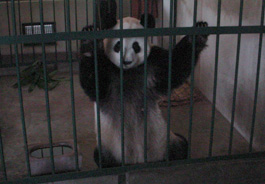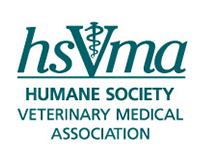Panda Chronicles
A Veterinarian’s Firsthand Perspective on the Health and Welfare
of Giant Pandas in China’s Breeding Industry
 A giant panda mother named Yaya follows the cub that has just been taken from her. She wants her baby back. Dr. Kati LoefflerMarch 19, 2015
by Kati Loeffler, DVM, PhD, MRCVS
Few creatures are more helpless than newborn giant panda cubs. They disappear in the palm of their mother’s gentle paw. They have no functioning immune system. They are blind, deaf, hairless, and unable to propel their little bodies. What they do have is a voice that’s ten times the size of their bodies, and a very big mouth for suckling. A panda mother’s attentions are imperative, and a panda baby isn’t going to let her forget it – not that she ever would.
One of the most poignant events that we witness in our work as veterinarians is a mother’s acceptance of her newborn, and the beginning of the maternal bond. The maternal investment of giant pandas is tremendous. Mothers hold their cubs in their great paws without ever letting them touch the ground for weeks. Giant pandas have not evolved to go without food for long periods of time, but panda mothers may remain in the nest for as long as two weeks after an infant’s birth, foregoing both food and water.
The giant panda breeding industry in China does not see poignancy in the maternal moment, nor does it appreciate the inborn expertise that animal mothers possess to care for their offspring. The industry’s prevailing attitude toward animal care is that humans always know better what the animal should be doing than the animal does herself. There is fundamentally no respect within the industry for the sentience of animals, nor for their inherent skills that have been honed over millions of years of evolution.
I began working with giant pandas nearly 15 years ago, as a somewhat idealistic research veterinarian affiliated with the Smithsonian Institution. My project was to investigate infectious diseases of giant pandas in China. At that time, infant mortality rates were high, pandas failed to thrive, and visiting tourists viewed dull, lethargic animals. I arrived at the giant panda breeding facility in Chengdu with enthusiastic plans and great expectations for the importance of our research.
Within 24 hours of my arrival, I found myself watching a giant panda whose newborn cub had just been torn from her by the keepers. She was trying to bury her face in the corner of her fluorescent-lit cement cell with bars on three sides and no privacy, peace, or comfort. I realized then that my job was not as much about understanding disease or improving health, as it was to figure out how to turn panda welfare into profit. I had come face-to-face with the realities of the giant panda breeding industry, and there is nothing cute and fluffy about it.
Forced Maternal Neglect
That cub was dead a few days later. The common practice at that time was to remove cubs the moment they were born, because panda mothers were considered unfit to raise them. They were placed in an incubator and fed human baby formula. If they didn't die of failure of passive transfer, they died of diarrhea and malnutrition. In effect, they died of forced maternal neglect, ironically imposed by humans whose objective was to breed pandas in order to save the species.
|
In the panda breeding industry, the emphasis is on cub numbers... To ensure that females come into estrus [each] spring, their cubs are taken from them...[some at] only three months old [when they are] just beginning to take their first wobbly steps.
|
In the wild, cubs remain with their mothers for at least 18 months. During that time the panda mother does not mate, and invests all her energies in raising a single, healthy cub that is physically and socially fit to thrive independently. Thus, female pandas raise a cub on average once every four years. In the panda breeding industry, the emphasis is on cub numbers, and to breed each mature female every year. To ensure that females come into estrus in the spring, their cubs are taken from them by the preceding December. Some cubs are only three months old—just beginning to take their first wobbly steps. The inhumanity of forced artificial reproduction methods – artificial insemination and sperm collection – for male and female pandas is a topic for another article.
I campaigned hard for cubs to at least be allowed colostrum, if not full maternal care. I provided literature on the necessity of passive transfer, and garnered the support of my colleagues at the Smithsonian and at other American zoos exhibiting pandas. Our Smithsonian pathologist established that cubs were dying of sepsis associated with a lack of immune defense. If nothing else, I suggested in a desperate moment, at least give cubs maternal serum, as we sometimes do for orphaned neonatal calves and foals.
No, was the answer from the breeding facility management. Despite the fact that cub survival was extremely poor, there was a refusal to hear us, to believe us, to try anything different. Greatly to their credit, some of the breeding center staff were eager to try my suggestions. But they couldn’t shake the status quo and the general fear of changing anything, lest it go from bad to worse and someone have to catch the blame.
NEXT: Misguided Preventive Care and Nutrition»
«First 1 2 3 Last»
|

